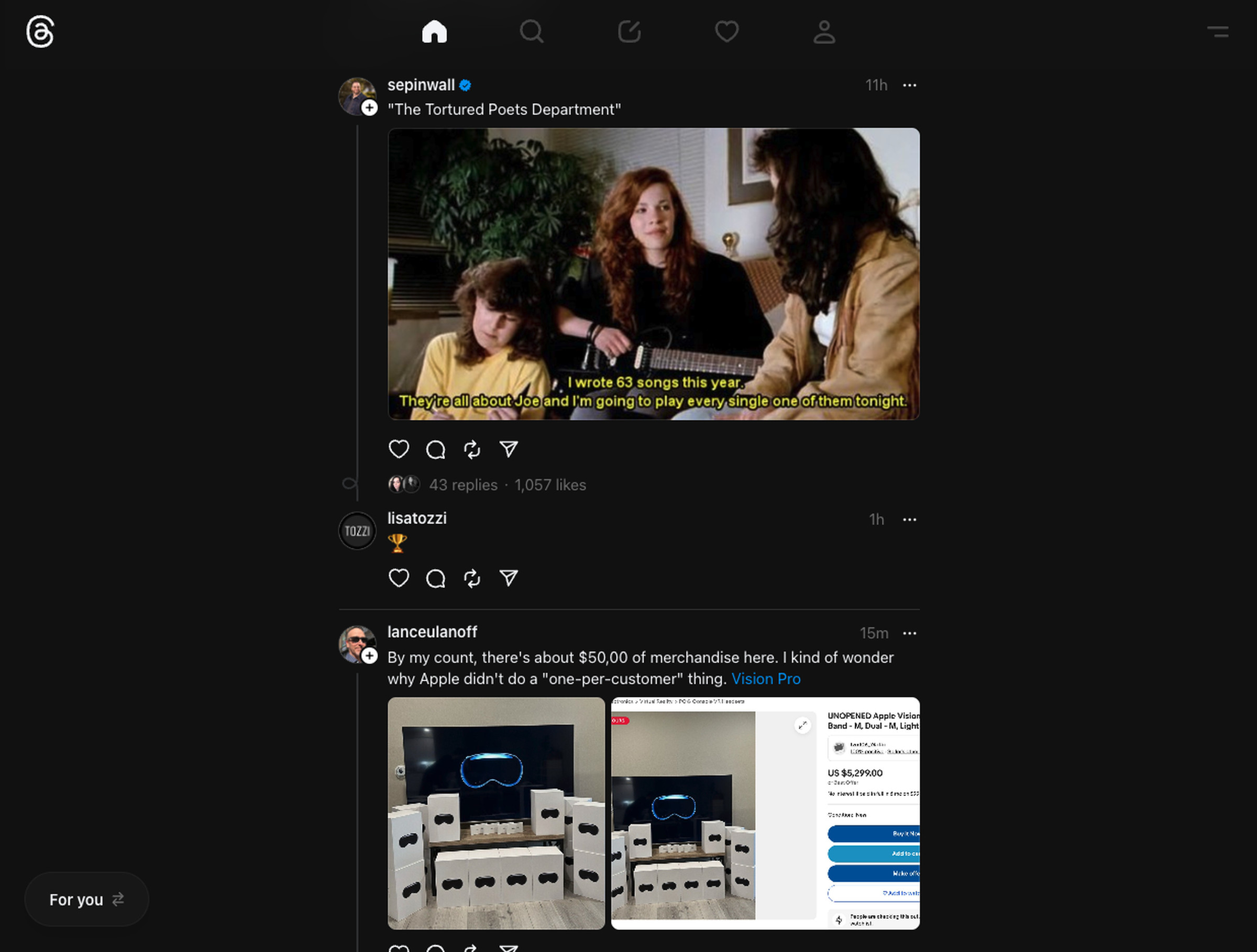The buzziest new thing in social networking is a big deal. It’s also very confusing. And it’s not actually new. Let’s talk about it.

At some point over the last year, you’ve probably come across the term “fediverse” a few times. Maybe you’ve read about it here at The Verge or seen some internet oldhead talking on their blog about how this is the internet they were hoping for back in 1993. Maybe someone sent you that “Protocols, Not Platforms” article so you’d think they were smart.
The fediverse is a little like HTTP or the nitrogen to oxygen ratio in the air: very important, all around you, but probably not something you need to think about in your day to day. But if the fediverse is actually going to change the internet — and I think it might — it’s worth understanding just a little better.
So I’ve read the posts. I’ve talked to the oldheads. I have protocol-ed. I have platform-ed. And I think I can help. Let’s just dive in:
So what is the fediverse?
It’s an interconnected social platform ecosystem based on an open protocol called ActivityPub, which allows you to port your content, data, and follower graph between networks.
Ugh, I know. Let me try again.
The fediverse is as if you took X, TikTok, Snapchat, Instagram, and Facebook and made them all interoperable so you could post anything from anywhere, and all your followers would be guaranteed to see it. And if you wanted to leave one platform for another, you could bring all your content, all your followers, all your everything with you.
Oh, so it’s a new social network! Why didn’t you just say that?
It’s actually lots of new social networks! A bunch in the fediverse already exist, and lots more are coming. But the interconnection is the thing: instead of having all your Facebook stuff on Facebook and all your X stuff on X, the fediverse allows them to interoperate. That’s really the big shift here.
And this is some cool new thing someone just invented? Be honest with me: are you about to pitch me a Web3 thing?
Nope — it’s all based on a decades-old idea about how the internet should work and a protocol that has existed in some form since 2014 or so.
So why are you all riled up about this now?
Because, over the last couple of years, a lot of people have become acutely aware of the fact that social platforms are not stable places. Think of the way Twitter changed after Elon Musk bought it; a lot of people who had found connection and community on Twitter suddenly found… not that on Twitter. And then it stopped being Twitter. Now, it’s a bank or a cable network or whatever.
Meanwhile, millions of creators, who spent years building followings and businesses on these platforms, are discovering just how quickly all of that can go away. Algorithms change, company priorities shift, and suddenly, you’re either hawking stuff in the TikTok Shop or you’re getting buried in the feed.
So people are looking for platforms where they’re not stuck. Where, if they want to leave for somewhere else, they can take not just their posts but their entire list of followers with them. Where they’re not immediately cut off from all their communities just because they delete an app. You know how everyone online is like, “Give me your email, it’s the only stable thing on the web, and so it’s the most important tool for building a lasting audience” now? The fediverse offers that same stability because all your stuff is yours — the apps just borrow it.

Why should I care about any of that?
Think of all the places you follow people or the fact that you have a long history of posts on Instagram that isn’t remotely correlated to your history of posts on TikTok or Facebook or YouTube or anywhere else. Wouldn’t it be better if all that stuff were in one place, controlled by you, and you could move it from app to app and platform to platform as you wanted? And you didn’t have to be on a hundred different apps with a hundred different algorithms just to get the content you care about? And the places where you connect with your friends, or make a living as a creator, couldn’t be irrevocably destroyed by a billionaire with a sink and a bunch of weird ideas about financial products?
The ActivityPub protocol I mentioned a minute ago is a little like email: it has specifications for senders and receivers and supports lots of different kinds of content. It produces what you might call “posts” in a universally understandable format.
Think about ActivityPub as just, like, a gigantic bucket of content. All the posts, likes, comments, followers, everything, all in the bucket. Every time anyone posts, from any of the apps I just mentioned, it goes into the bucket. Any app that wants to can read and write those posts, just as any app can write something that any other app will understand as “an email.”
So the fediverse is just ActivityPub?
Sort of. There are other protocols out there for sharing these kinds of posts, and a web-wide fediverse could be built in any of them. Bluesky uses one called the AT Protocol, which people seem to like a lot, and there’s also Farcaster and Nostr and I’m sure a bunch of others I don’t even know about.
But all of this stuff only works if there is a standard, and I’d bet $10 that ActivityPub is going to be that standard. It’s the one that’s overseen by the World Wide Web Consortium, it’s the one with the most momentum, it’s the one Threads is supposedly going to support — it’s just kind of clearly winning.
Hang on — Threads is part of the fediverse?
Technically, no. Or at least not yet. But from the beginning, Meta has been promising to federate Threads, so you’d be able to read Threads posts in Mastodon or post from Mastodon and see it in Threads. It’s already rolling out some of that stuff, so I’m optimistic it’ll happen. And it’ll be the first mainstream ActivityPub app, since Mastodon isn’t quite there.
Oh Mastodon! I’ve heard of Mastodon.
Nice! Mastodon has been the leading ActivityPub platform for years now.
So why aren’t we just talking about Mastodon then?
Fair enough — I probably should have mentioned it earlier. But I think people get tripped up when they get too attached to Mastodon, because Mastodon isn’t the fediverse. Mastodon is an app in the fediverse, compatible and interconnected with all of the other ones. But if you think Mastodon is too complicated or too weird about “the bird app,” that’s actually fine, because the fediverse is bigger than Mastodon.
So Mastodon is one, like, thing in the fediverse.
I’m so sorry to do this, but it’s actually slightly more complicated than that. Mastodon is both an app in a federated ecosystem and a federated app itself. Mastodon is actually a collection of many “instances” that can all talk to each other. So if you’re on mastodon.social, which is the biggest Mastodon instance, and I’m on mastodon.xyz, we’re technically using two different installations of the same app, but because of federation, we’re able to follow each other and reply to each other’s stuff.
Think about it like this: Reddit is one thing, but it’s made up of lots of individual things — subreddits — each with their own rules and moderators and weird ideas about emoji. Each subreddit is its own thing, but they’re all connected via a larger system. It’s just that in this case, instead of the company Reddit running the whole thing, each of those subreddits (or Mastodon instances) is completely controlled by whoever is hosting the server.

What else is out there? And you can’t say Threads. You just said it’s not part of it yet.
Pixelfed is one of my favorites, kind of like Instagram for the fediverse. Lemmy is the Reddit-y app. PeerTube is building a YouTube-style app for the fediverse. Friendica is kind of like Facebook. BookWyrm has some Goodreads-like features, and people are digging Misskey. There are lots of them!
I haven’t heard of any of those things.
You should try BookWyrm in particular. It’s great. But okay, let’s see: what about Flipboard, which is in the midst of pivoting its entire platform to ActivityPub? That one’s cool. Medium is also getting on board, and Mozilla’s building some stuff. Last year was the year everyone went, “The fediverse is gonna be so sick, you guys!” This year is the year products start to ship for real.
But you’re definitely right that there’s no mainstream success story yet. Mastodon is by far the biggest thing in the fediverse, at least for now, and it’s still teeny tiny compared to Facebook and the like.
But eventually, all these apps are supposed to work together somehow?
You’re getting it! Ultimately, it’s not important for there to be one fediverse app the size of Facebook because the fediverse can be the size of the internet. Every app just has to plug in, and it’s already humongous.
But to your question: apps can work together as much or as little as they want. Lots of apps will just stick to their own universe, and at that point, the best thing about the fediverse is that you can easily move your data between apps. So if your favorite video sharing app shuts down, no problem; you just move all your stuff to another one, and you’re right back where you were.
But the coolest version of the fediverse is the one in which things fully interoperate, and each app gets to treat all your posts, likes, and replies however it sees fit, and you pick the apps that feel right to you. Already, Flipboard has an algorithm for sorting posts by topic and then showing them in pretty ways for easy reading; PeerTube looks specifically for videos; Mastodon puts all the posts in order in a timeline view, kind of like Twitter. Different apps can apply different content moderation, different UIs, different sorting algorithms, different everything, but it’s all still the same stuff.
But — and here’s where it gets cool — if you like one of my posts in Flipboard, I can, in theory, see it in my Mastodon notifications because that’s where I choose to look at what’s in the bucket. If you reply to my Mastodon post, I can read it as a comment on my article in Flipboard. All the stuff is everywhere, and you get to pick how you interact with it.
Again, this all relies on everyone working together to make this stuff seamless, which is hard work, but it could be really cool.
That does sound cool! And confusing.
It is very much both of those things. If you use a bunch of different apps, are you going to see all the same posts everywhere? Maybe. Are some ActivityPub apps going to be filled with content and posts that don’t belong there? Probably. This is all going to take time to sort out because it’s not just New Facebook — it’s an entirely different way of thinking about how we’re social online.
It’ll be weird for a while, but then a lot of people think it’s going to be way better.

So who am I in the fediverse? Do I get, like, a universal username?
I suspect, at the end of this, you will have something like a universal username. (That’s another solution to what sucks about closed platforms; you’re always racing to get your own username, and frankly, I find it very annoying to be @pierce some places and @davidpierce other places and @imdavidpierce sometimes and @davep3355 on at least one service, for some reason.)
You can always have different accounts for different things, but I think many people will end up having one main identity — your Threads username, or your Mastodon handle, or even a domain you hook up to all of these services individually — that ports across all of these systems. Think of it like your email address: it doesn’t matter what app you use to check your email or what someone else is using to email you, they just know how to reach you.
What do those usernames look like?
They’re different everywhere, but everyone’s big on @symbols. Mastodon uses two of them, which I find ridiculous: I’m @davidpierce@mastodon.social, which looks silly. Just make it look like email addresses, people!
Is there money in this for any of these companies?
Not so much, at least right now. In theory, there could be lots because, instead of there being one behemoth Facebook, you could have 100 companies each building a single Facebook feature and doing it better and with more focus. There’s no reason this couldn’t be a huge industry. But right now, it all seems to be at the level of “some people with some Patreons” money and not “buying several islands you didn’t even know existed” money.
Are the Facebooks of the world ever going to join the fediverse?
Honestly, probably not. Even Meta, which is definitely invested in the idea of the fediverse, would have a truly brutal time rearchitecting Facebook and Instagram to work on ActivityPub. There’s not much chance of that happening, which is why the Threads move is so interesting. Meta’s going to try to have it both ways for a while, but ultimately, if the fediverse is going to work, it’s going to be on the back of a bunch of new services, not the ones we have now.
So why would I leave Instagram and Facebook?
That’s the big question. Do you like Instagram and Facebook?
I mean, sure. It’s where all my friends are.
That is the single biggest problem for the fediverse. A lot of folks I’ve talked to say that, basically, if we’d built social media like this 20 years ago, the world would be better and smarter and we’d all be richer and better-looking. (Or something.) But we didn’t. We built it on a bunch of closed platforms that turned out to be really sticky, really lucrative for the companies that made them, and frankly kind of user-hostile. But it’s really, really hard to convince people to stop hanging out where their friends are and go join something new just because it’s better. That transition will take a long time, if it ever happens.
Got it. Any other downsides?
Oh, boy — where do I start?
Discovery is the big one: neither Mastodon nor anybody else has built really good fediverse-wide tools for finding people, so you’re going to have a tough time finding everyone you care about unless they all happen to be on your server.
This kind of decentralization also means that if you’re just a person who set up a server in your basement to host Mastodon, you’re suddenly responsible for content moderation and hosting costs and site maintenance and a bunch of other stuff. There are, and will be, big teams working on these problems. There will also be servers in basements, and things will get weird and fragile and messy. You could be one of those basement-server-havers! You could roll your own social network and also be part of the internet-wide social network. How cool is that?
No, thanks.
That’s fine. Probably a good call. Running a social network is a lot of work and seems to involve a lot of getting yelled at by Congress. Tread lightly.
You’ve convinced me, I’ll get a weird username with two @ symbols and try this out. Last question: why is it called “fediverse” again?
One of the terms people use for this is “federated social networking.” Federation is the idea of decentralizing and distributing something so it’s not controlled and stored in a single place.
Beyond that… I guess the metaverse was also a big thing when people were figuring out what to call this. So we got “fediverse.”
We really can’t do any better than that?
You’re preaching to the choir here, my friend. Some people are trying to make “open social web” happen, but I think we’re stuck with the fediverse. Good news, though: if this thing really works out, you won’t have to ever think about it again. You’ll just use your apps, and the fediverse will make them awesome.
This post was originally published on this site be sure to check out more of their content








